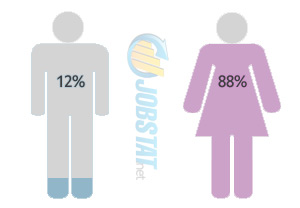Medical Records Technician
Job Description
Medical records technicians are responsible for entering patient medical records into virtual database. All of the medical records that are entered by an MRT must be accurate, accessible, and up-to-date. While a medical records technician does not communicate directly with a patient, they are an extremely important part of the industry.
When patients see a doctor or a specialist, doctors must have access to their records to properly diagnose and treat a medical problem. An MRT will receive doctors notes, enter the data into a computer database, and make this information available to everyone with authority. Obviously, all of this data must be accurately recorded in a timely manner to ensure patients receive quality care in the future.
Salary
Salaries in the field depend on education, experience, geographical area, and the employer. In 2011, the average salaries reported for medical records technicians in the United States ranged between $29,000 and $33,000. The entire salary range reported was between $21,000 and $53,000. Typically, hospitals and government agencies pay better than independent practices. Most MRTs are paid hourly and have the option to earn overtime. Below is a graph showing the average salaries reported in the nation:
Medical Records Technician Salary Statistics For 2015
| Salary | Hourly | Bonuses | States | Cities | Historical |
Specialized Fields
* Registered Health Information Technician- A certified technician who passes an exam conducted by AHIMA. * Certified Tumor Registrar- A certified technician who receives their certification through the National Cancer Registrars Association.
Work Environment
Medical records technicians typically work full-time 40 hour weeks when they are employed by a hospital, healthcare facility, or an established doctor. Between 40% and 50% of all MRTs that work in the industry are employed by hospitals and medical care facilities. The other 50% of technicians in the field work for private doctors and other clinics who do not provide medical care. The responsibility of each technician may vary from job to job, but all technicians work in an office environment behind-the-scenes.
The typical day at work for a medical records tech involves reviewing medical records, extracting all of the important details from these records, and entering all of the significant information into a company-wide database. The database that the technician works with will depend on the environment in which they work. While MRTs typically work on their own, they may need to communicate with doctors and nurses to clarify notes that are not clear. Because of this, an MRT needs to be strong in communication.
Job Outlook
Radiologist Gender Employment Statistics |
|
 |
Based on our stats gathered across the U.S. 88% of medical record technicians were females while only 12% were males. These numbers are based on averages across all states combined. Some individual states may have a much different ratio however. |
There is a strong job outlook for medical records technicians. With a large population of aging Baby Boomers who have a heightened need for medical care, the demand for medical records techs is expected to grow. According to the Bureau of Labor Statistics, demand for trained and certified medical records techs will grow by 20% in the next decade alone. With more and more doctors offices and medical care facilities utilizing electronic health records in their offices, demand for experienced MRTs will remain high. For individuals who want to start a new, stable career, this field may be a great choice.
How to Become a Medical Records Technician
You must have at least a GED or high school diploma to be hired as an MRT. While some employers will hire you with no experience, more and more doctors and hospitals are looking for candidates who possess an associate’s degree and have completed a training program specifically tailored to teach MRTs their duties and responsibilities. Upon completion of a training program, the student will take a certification exam to become certified as a Registered Health Information Technician.
You can find training programs through junior colleges, technical schools, and vocational schools. These courses will teach students about the medical coding systems, how to analyze data, and insurance practices. For technicians who want to specialize in recording details on cancer diagnosis, they can complete a special course and exam offered by the National Cancer Registrars Association.
To earn your certification, you must be 18 years of age and pass a background check. Prior conviction may affect your ability to qualify for certification. Only after passing the exam and the background check, will the student receive their certification to better their chances of finding a high paying position.

